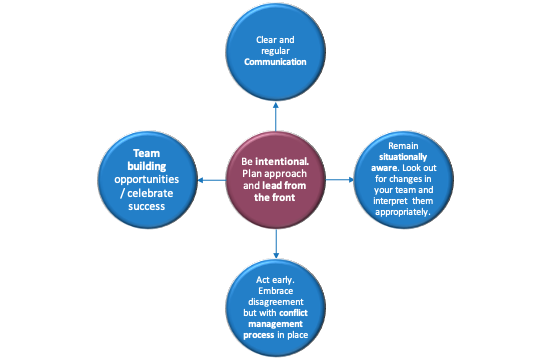Communication in Virtual Teams: Understanding individual differences
April 16, 2020Communicating through uncertainty
April 16, 2020Context
Teams may be more susceptible to unhealthy conflict due to:
- Heightened levels of stress: when we are stressed our ability to rationally evaluate information can be hindered, and we tend to look for, and focus on what we perceive is threating. Our ability to regulate emotion is also impaired, and we can be less tolerant of others. See Stress and Resilience for more info.
- Lack of face-to-face contact: without verbal cues we miss the impact of body language, tone, intonation and volume, and misunderstandings can occur.
- Lack of context and delays in communication can lead people to “fill in the gaps” and misperceive information. In the absence of information people tend to assume the worst not the best intentions of others.
- “Online disinhibition effect”: people can be more harsh or aggressive online.

Purpose
- In the current context, managing conflict is more important than ever. Conflict can lead to low staff morale, low productivity, high absenteeism and impaired exchange of critical information.
- While it can be distressing, conflict it is a completely normal part of working in teams. If managed well, there can be a number of benefits, such as better business decision making, innovation, and heightened team morale.
What you can do as a leader?
- Be intentional and proactive about how your team will run in the new remote environment and plan how you will deal with conflict. HINT: Empower staff to think about how they can keep (or improve) team culture and develop expectations and norms for working remotely. Make sure you reflect on how things are going so you can continuously improve. Lead from the front, and model appropriate behaviours.
- Communicate clearly and regularly. Where appropriate, use video conferencing tools so your team can pick up on visual cues. Just like you would never tell your loved one only once that you love them, repetition is key to communicating and people believing you.
- Remain situationally aware. Keep an eye open for any indicators of disagreement and look out for any behavioural changes in your team. Have regular one-on-one conversations with your team to see if they’re okay.
- If conflict does occur, address it as early as possible. Have a process in place:
- Engage in a discussion with those involved, preferably face-to-face video conferencing.
- Identify the problem and work out the underlying reasons for the conflict. Any gaps in communication?
- Come up with an agreed, goal focused plan. Focus on the future.
- Seek external assistance if appropriate. Use employee support services (EAP) or mediation (e.g.,Employment NZ)
- Set up team building and engagement opportunities and celebrate great teamwork and success.
Additional References
- Communication in a time of social distancing: Strengthening virtual teams
- Remote Team Conflict
- Five ways to effectively handle conflict in virtual teams
- How managers can effectively lead newly remote teams during Covid 19
